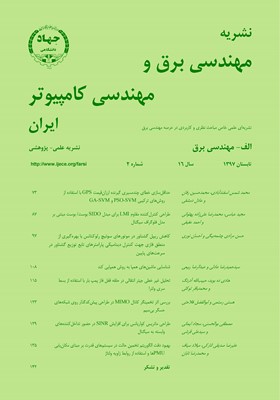شناسايي ماشينهاي همپا به روش همپايي کند
محورهای موضوعی : electrical and computer engineeringسيدحميدرضا عادلي 1 , عبدالرضا ربیعی 2 *
1 - دانشگاه شهرکرد
2 - دانشگاه شهرکرد
کلید واژه: معادلسازي ديناميکيهمپاييمدهاي کندشناسايي همپايي,
چکیده مقاله :
بررسي پايداري، کنترل و طراحي سيستمهاي قدرت امروزي به دليل وسعت زياد و پيچيدگي بيش از حد اين سيستمها، کار مشکلي بوده و براي انجام چنين مطالعاتي، معادلسازي ديناميکي اين سيستمها بسيار مفيد و گاه اجتنابناپذير ميباشد. در اين مقاله از روش همپايي به عنوان روش معادلسازي و از روش همپايي کند به عنوان روش شناسايي ماشينهاي همپا استفاده شده است. اين روش با وجود سادگي، روش مؤثري در شناسايي ژنراتورهاي همپا ارائه ميدهد. همچنين در اين مقاله، روش جديدي براي خوشهبندي ماشينهاي سنکرون ارائه شده که داراي سرعت قابل قبولي ميباشد. در پايان صحت عملکرد روش شناسايي پيشنهادي توسط شبيهسازي زماني مورد بررسي قرار ميگيرد و با روشهاي ديگر مقايسه ميگردد. نتايج حاکي از آن است که با استفاده از روش مذکور، گروههاي ژنراتوري با سرعت بالاتري نسبت به ديگر روشها تعيين ميشود و لذا روش پيشنهادي ميتواند با دقت خوبي در مطالعات معادلسازي ديناميکي استفاده گردد.
To study the stability of dynamic systems, it is neither practical nor necessary to model the entire interconnected system in details. In more specific application, such as dynamic security assessment and system control design, reduced order models of the entire system, or part of it, are needed to satisfy computational or design constraints. In this paper, a dynamic reduction method based on coherency concept is developed and slow coherency identification is used to identify coherency machine. Despite its simplicity, the proposed method provides an effective approach to recognize coherence generators. Furthermore, a new clustering method is suggested in this paper to improve acceleration of coherence machines identification. Finally, the accuracy of proposed method is evaluated by time domain simulation and compared with other methods. The obtained results indicate that the new proposed grouping method works more quickly than the other methods in the area, concluding that, without loss of accuracy, it can be readily used in dynamic studies of power systems.
[1] R. Podmore and A. Germond, Development of Dynamic Transient Stability Study, EPRIL-156, 1977.
[2] A. Chang and M. Adibi, "Power system dynamic equivalents," IEEE Trans. on Power Apparatus and Systems, vol. 89, no. 8, pp. 1737-1743, Nov. 1970.
[3] R. Podmore, "Identification of coherent generators for dynamic," IEEE Trans. on Power Apparatus and Systems, vol. 97, no. 4, pp. 754-763, Feb. 1981.
[4] S. T. Y. Lee and F. C. Schweppe, "Distance measure and coherent recognition for transient stability equivalents," IEEE Trans. on Power Apparatus and Systems, vol. 92, no. 5, pp. 1550-1557, Sept. 1985.
[5] M. Y. Hussain and V. G. Rau, "Coherency identification in power system control, operation and management," in Proc. Int. Conf. on Advacees in Power System Control Operation and Management, APSCOM'93, vol. 2, pp. 887-892, Hong Kong, 7-10 Dec. 1993.
[6] N. Gacic, A. I. Zecevic, and D. D. Siljak, "Coherency recognition using epsilon decomposition," IEEE Trans. on Power System, vol. 13, no. 2, pp. 314-319, May 1998.
[7] R. Nath, S. S. Lamba, and K. S. Parkasa Rao, "Coherency base system decomposition into study and external area using weak coupling," IEEE Power Engineering Review, vol. 104, no. 6, pp. 52-53, Jun. 1985.
[8] B. Avramovic, P. V. Koktovic, J. H. Chow, and J. R. Winkelman, "An analysis of interarea dynamics of multi-machine systems," IEEE Trans. on Power Apparatus and Systems, vol. 100, no. 2, pp. 754-763, Feb. 1981.
[9] M. H. Haque and A. H. M. A. Rahim, "Identification of coherent generator using energy function," IEE Proceedings C - Generation, Transmission and Distribution, vol. 137, no. 4, pp. 255-260, Jul. 1990.
[10] A. S. Mcfarlane and R. T. H. Alden, "Coherent grouping of power systems for use in training artificial neural networks," in Proc. 36th Midwest Symp. on Circuits and Systems, vol. 7, pp. 1559-1564, Detroit, MI, USA, 16-18 Aug. 1993.
[11] S. Avdakovic, E. Becirovic, A. Nuhanovic, and M. Kusljugic, "Generator coherency using the wavelet phase difference approach," IEEE Trans. on Power Systems, vol. 29, no. 1, pp. 271-278, Jan. 2014.
[12] R. Agrawal and D. Thukaram, "Identification of coherent synchronous generators in a multi-machine power system using support vector clustering," in Proc. IEEE Int. Conf. on Power and Energy Systems, ICPS’11, 6 pp., Chennai, India, 22-24 Dec. 2011.
[13] H. Verdejo, G. Montes, and G. Olguin, "Identification of coherent machines using modal analysis for the reduction of multimachine systems," IEEE Latin America Trans., vol. 12, no. 3, pp. 416-422, May 2014.
[14] N. Senroy, "Generator coherency using the Hilbert-Huang transformer," IEEE Trans. on Power System, vol. 23, no. 4, pp. 1701 -1708, Nov. 2008.
[15] T. Guo and J. V. Milanovic, "Identification of power system dynamic signature using hierarchical clustering," in Proc. IEEE PES General Meeting | Conf. & Exposition, 5 pp., National Harbor, MD, USA, 27-31 Jul. 2014.
[16] F. Wu and Y. K. Tsai, "Identification of groups of epsilon-coherent generators," IEEE Trans. on Circuits and Systems, vol. 30, no. 4, pp. 234-241, Apr. 1983.
[17] P. V. Koktovic, J. J. Allemong, J. R. Winkelman, and J. H. Chow, "Singular perturbation and iterative separation of time scale," Automatica, vol. 16, no. 1, pp. 23-33, Jan. 1980.
[18] P. M. Anderson and A. A. Fouad, Power System Control and Stability, Iowa State Press. Ames, Iwa, 1977.
[19] م. پرنياني و ا. صفدري، "شناسايي و معادلسازي ماشينهاي همپا در مدل ديناميک سيستم قدرت،" مقالات پژوهشي دانشکده شريف، جلد 1، شماره 16، صص. 29-19، 1378.
[20] م. پرنياني و س. ح. ر. عادلي، "شناسايي ماشينهاي همپا به روش تابع انرژي،" کنفرانس بينالمللي برق، 6 صص.، مشهد، 24-22 اردیبهشت 1383.

